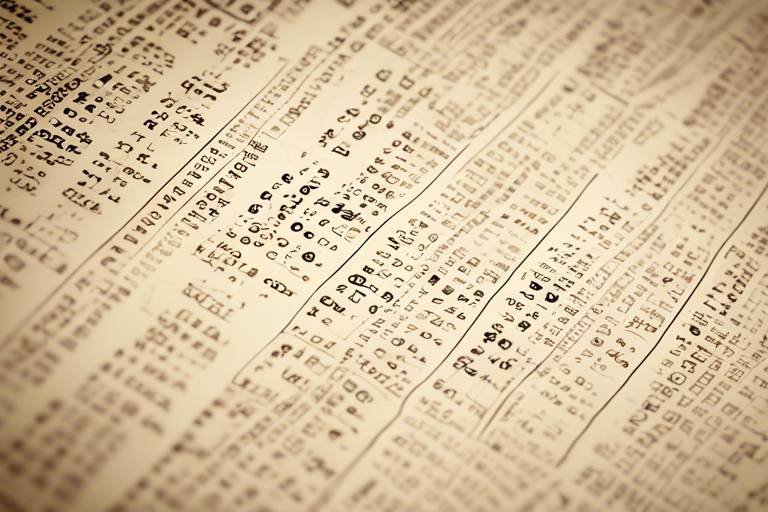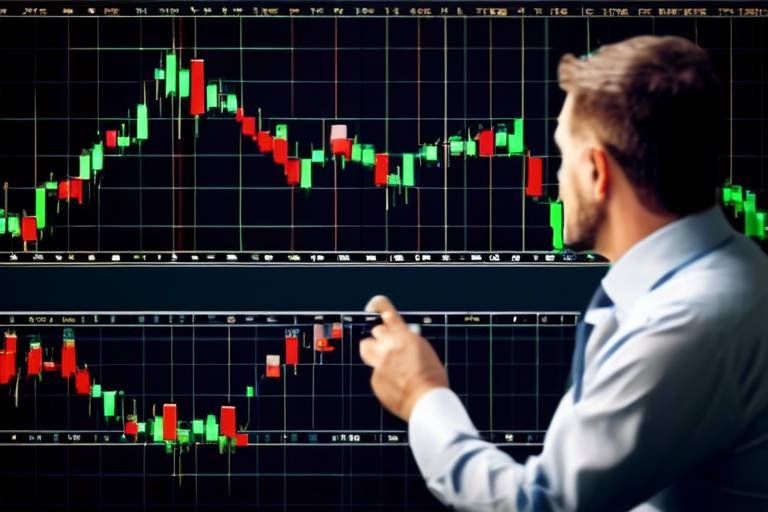How to Use Technical Analysis to Optimize Entry and Exit Points
In the fast-paced world of trading, understanding when to buy and sell can mean the difference between profit and loss. This is where technical analysis comes into play, acting as a guiding compass for traders navigating the unpredictable waters of the financial markets. By analyzing historical price data and trading volumes, technical analysis allows traders to forecast future market movements, helping them make informed decisions. But how do you leverage this powerful tool to find the optimal entry and exit points for your trades? Let's dive into the fundamentals.
At its core, technical analysis is all about studying price movements and trading volumes. Think of it as a detective piecing together clues to predict what might happen next. Traders use various tools and indicators to analyze trends and patterns that can indicate where prices are headed. Some of the key principles include:
- Price Discounts Everything: The market price reflects all available information, including news and economic indicators.
- Price Moves in Trends: Prices tend to move in trends, which can be upward, downward, or sideways.
- History Tends to Repeat Itself: Historical price movements often repeat, allowing traders to identify potential future movements.
By understanding these principles, traders can better position themselves to make profitable trades. The next step is to identify the right entry points, which is crucial for maximizing profits.
Identifying the right entry points is like finding the perfect moment to jump into a moving train. If you time it right, you’ll enjoy a smooth ride; if not, you might end up missing your chance. Various technical indicators can help traders pinpoint these optimal entry opportunities. Among the most popular are Moving Averages and the Relative Strength Index (RSI).
Moving averages are essential tools in technical analysis that help smooth out price data to identify trends over time. They act like a safety net, filtering out the noise of daily price fluctuations. There are two primary types of moving averages that traders commonly use:
The Simple Moving Average (SMA) is calculated by adding the closing prices of a security over a specific time period and dividing that sum by the number of periods. For instance, a 10-day SMA takes the average of the last 10 days' closing prices. Traders often look for crossovers between the SMA and the price line as potential entry signals. When the price crosses above the SMA, it might indicate a good buying opportunity.
The Exponential Moving Average (EMA) gives more weight to recent prices, making it more responsive to new information. This is particularly advantageous in volatile markets where price changes can happen rapidly. Traders often use the EMA to identify potential entry points by looking for crossovers, just like with the SMA, but with a more immediate reaction to price changes.
The Relative Strength Index (RSI) is a momentum oscillator that measures the speed and change of price movements. Ranging from 0 to 100, the RSI helps traders identify overbought or oversold conditions. When the RSI exceeds 70, it may indicate that a security is overbought, while an RSI below 30 may suggest it's oversold. These conditions can signal potential entry points, allowing traders to capitalize on price reversals.
Knowing when to exit a trade is just as important as knowing when to enter. Think of it like a game of chess; you need to anticipate your opponent's moves and know when to make your exit. Several strategies and indicators can assist traders in determining optimal exit points for maximizing profits. One effective method is setting profit targets based on technical analysis principles.
Establishing profit targets helps traders lock in gains and avoid the temptation to hold onto a trade for too long. Methods for setting realistic profit targets can include using Fibonacci retracement levels or previous support and resistance levels. These targets act like a safety net, ensuring that you secure profits before market conditions change.
Stop-loss orders are essential for managing risk in trading. By setting a predetermined price at which a trade will be closed, traders can protect their investments and determine exit points when trades go against expectations. It's like having a parachute ready in case your jump doesn't go as planned—better safe than sorry!
- What is the best indicator for entry points? Different traders prefer different indicators; however, moving averages and RSI are widely used for their effectiveness.
- How do I set a stop-loss order? A stop-loss order can be set through your trading platform, where you specify the price at which you want to sell.
- Can technical analysis guarantee profits? While technical analysis can improve decision-making, it cannot guarantee profits due to the unpredictable nature of the markets.

Understanding Technical Analysis
Technical analysis is a powerful tool in the world of trading, enabling traders to make informed decisions based on historical price movements and trading volumes. Imagine standing in a bustling marketplace, observing the ebb and flow of buyers and sellers. Just like a savvy market trader, a technical analyst uses data to predict where prices might head next, allowing them to seize profitable opportunities.
At its core, technical analysis is about understanding market psychology. Traders believe that all relevant information is already reflected in the price of an asset. Thus, by analyzing historical price charts and volume patterns, traders can glean insights into potential future movements. But how do they do this? Let's explore some key principles and tools that form the foundation of technical analysis.
One of the primary principles of technical analysis is the concept of trends. Markets tend to move in trends, whether upward, downward, or sideways. Recognizing these trends is essential for making successful trades. Traders often look for patterns or formations in price charts, such as head and shoulders, flags, and triangles, which can indicate potential reversals or continuations of trends.
Technical analysts also utilize various tools to aid their decision-making process. Some of the most popular tools include:
- Charts: Line charts, bar charts, and candlestick charts provide visual representations of price movements over time.
- Indicators: These mathematical calculations, such as moving averages and the Relative Strength Index (RSI), are plotted on charts to help traders identify trends and potential entry/exit points.
- Volume analysis: Understanding trading volume can provide insights into the strength of a price movement. High volume during a price increase may indicate strong buying interest, while low volume could suggest a lack of conviction.
Moreover, technical analysis is not just about numbers and charts; it’s also about timing. The ability to determine when to enter or exit a trade can significantly impact profitability. By mastering the tools and principles of technical analysis, traders can enhance their chances of making successful trades while minimizing risks.
In conclusion, technical analysis serves as a vital compass for traders navigating the complex waters of the financial markets. By understanding price trends, utilizing various analytical tools, and grasping market psychology, traders can make more informed decisions that align with their trading strategies. So, are you ready to dive deeper into the world of technical analysis and unlock its secrets?

Key Indicators for Entry Points
When it comes to trading, finding the right moment to enter the market can feel like searching for a needle in a haystack. However, with the right technical indicators, you can significantly increase your chances of making profitable trades. These indicators serve as your compass, guiding you through the chaotic world of price movements and market fluctuations. Let's dive into some of the most effective indicators that can help you pinpoint optimal entry opportunities.
One of the most commonly used indicators is the Moving Average. This tool smooths out price data over a specified period, making it easier to identify trends. By observing the direction of the moving average, traders can determine whether the market is in an uptrend or downtrend. When the price crosses above the moving average, it often signals a potential buying opportunity, while a price drop below the moving average can indicate a good time to sell.
Moving averages come in different forms, but the two most popular types are the Simple Moving Average (SMA) and the Exponential Moving Average (EMA). Each has its unique characteristics and can be used to identify entry points in different market conditions.
The Simple Moving Average is calculated by taking the average of a set number of closing prices over a specific period. For instance, a 50-day SMA averages the closing prices of the last 50 days. This indicator is particularly useful for identifying long-term trends. When the price crosses above the SMA, it may indicate a bullish trend, suggesting that it could be a good time to enter a trade. Conversely, if the price dips below the SMA, it might be a signal to exit or short the market.
On the other hand, the Exponential Moving Average gives more weight to recent prices, making it more responsive to new information. This characteristic makes the EMA an excellent choice for traders looking for quick entry points in volatile markets. For example, if you notice that the price is consistently hovering above the EMA, it could be a strong indication that the trend is bullish, presenting a potential entry point.
Another vital indicator to consider is the Relative Strength Index (RSI). This momentum oscillator ranges from 0 to 100 and is used to measure the speed and change of price movements. Typically, an RSI above 70 suggests that the market is overbought, while an RSI below 30 indicates that the market is oversold. These levels can help traders identify potential entry points. If the RSI crosses back below 70 after being above it, it could signal a good opportunity to sell. Conversely, if the RSI crosses back above 30 after being below it, it might be time to buy.
In conclusion, understanding and utilizing these key indicators can significantly enhance your trading strategy. By combining moving averages and the RSI, you can develop a robust framework for identifying optimal entry points in the market. Remember, the key to successful trading lies not just in knowing when to enter but also in having the discipline to follow your strategy consistently.
- What is the best technical indicator for beginners? The Simple Moving Average (SMA) is often recommended for beginners due to its straightforward calculation and ability to identify trends.
- How do I know when to trust an indicator? It's essential to use multiple indicators in conjunction to confirm signals. Relying on one indicator alone can lead to false signals.
- Can technical indicators guarantee profits? No, while technical indicators can improve your trading decisions, they cannot guarantee profits due to the unpredictable nature of the market.

Moving Averages Explained
Moving averages are one of the most widely used tools in technical analysis, acting like a compass that helps traders navigate the often tumultuous waters of the financial markets. By smoothing out price data over a specific period, moving averages help identify the underlying trend, making it easier for traders to make informed decisions. Imagine trying to find your way through a foggy landscape; moving averages clear the haze, revealing the direction in which the market is heading.
There are two primary types of moving averages that traders utilize: the Simple Moving Average (SMA) and the Exponential Moving Average (EMA). Each serves a unique purpose and can signal potential entry points based on different market conditions. Understanding the differences between these two can be the key to unlocking better trading strategies.
The Simple Moving Average (SMA) calculates the average price over a specific number of periods, providing a straightforward view of the price trend. For example, if a trader wants to calculate a 10-day SMA, they would sum the closing prices of the last 10 days and then divide by 10. This method is excellent for identifying long-term trends but can lag behind current market movements due to its equal weighting of all data points.
On the other hand, the Exponential Moving Average (EMA) gives more weight to recent prices, making it more responsive to new information. This characteristic makes the EMA particularly useful in volatile markets where rapid changes can occur. The formula for EMA involves a bit more math, but the essence is that it reacts more quickly to price changes than the SMA, allowing traders to enter or exit positions more strategically.
| Type of Moving Average | Calculation Method | Market Sensitivity |
|---|---|---|
| Simple Moving Average (SMA) | Averages past prices equally | Less sensitive, may lag |
| Exponential Moving Average (EMA) | Gives more weight to recent prices | More sensitive, reacts quickly |
In practice, traders often use moving averages in conjunction with other indicators to confirm entry points. For instance, if the price crosses above the SMA or EMA, it may signal a buying opportunity. Conversely, if the price drops below these averages, it could indicate a potential sell signal. By combining these signals with other tools, traders can create a more robust trading strategy that increases their chances of success.
In summary, moving averages are not just numbers on a chart; they are powerful indicators that can help traders make sense of price movements and trends. By understanding how to utilize both the SMA and EMA effectively, traders can better position themselves to optimize their entry and exit points in the market.

Simple Moving Average (SMA)
The is one of the most fundamental tools in the arsenal of any technical analyst. It’s like the bread and butter of trading strategies, providing a clear and straightforward way to gauge the direction of a stock or asset over a specific period. But what exactly is it? In simple terms, the SMA is calculated by adding the closing prices of an asset over a certain number of periods and then dividing that sum by the number of periods. This creates a smooth line on a price chart that helps traders visualize trends without the noise of daily price fluctuations.
So, why should you care about the SMA? Well, imagine trying to find your way through a dense fog. The SMA acts as a beacon, guiding you through the murky waters of price action. By smoothing out price data, it helps traders identify whether an asset is in an uptrend, downtrend, or sideways movement. This clarity is crucial when deciding when to enter or exit a trade. For example, if the price is consistently above the SMA, it may indicate a bullish trend, suggesting that it might be a good time to buy. Conversely, if the price is below the SMA, it could signal a bearish trend, indicating a potential sell opportunity.
To calculate the SMA, you can follow this simple formula:
| Period | Closing Prices | Calculation | SMA |
|---|---|---|---|
| 1 | $10 | $10 | $10 |
| 2 | $12 | ($10 + $12) / 2 | |
| 3 | $14 | ($10 + $12 + $14) / 3 |
In this example, if you were to calculate a 3-day SMA, you would take the closing prices of the last three days, add them up, and then divide by three. The resulting SMA would give you a clearer picture of the asset's price movement over those three days, eliminating the daily volatility that can often mislead traders.
However, while the SMA is a powerful tool, it’s important to use it in conjunction with other indicators. For instance, combining the SMA with momentum indicators like the Relative Strength Index (RSI) can provide a more comprehensive view of market conditions. This way, you can avoid false signals that might occur if you rely solely on the SMA. Think of it like a team of detectives; each one brings their unique skills to solve the case, and together, they provide a clearer picture of what’s happening.
In conclusion, the Simple Moving Average is a vital component of technical analysis that can significantly enhance your trading strategy. By understanding how to calculate and interpret the SMA, you can better identify entry points and make more informed trading decisions. Remember, the market is a dynamic environment, and utilizing tools like the SMA can help you navigate it more effectively.

Exponential Moving Average (EMA)
The is a powerful tool in the arsenal of traders, especially for those navigating the often turbulent waters of the financial markets. Unlike its counterpart, the Simple Moving Average (SMA), which treats all price points equally, the EMA gives more weight to the most recent prices. This characteristic allows the EMA to respond more swiftly to price changes, making it an invaluable asset for traders looking to make informed decisions in real-time. Think of the EMA as a seasoned captain steering a ship through stormy seas—it's agile and quick to adjust to new conditions, helping traders stay ahead of the curve.
To calculate the EMA, you need to follow a specific formula that incorporates the previous EMA value, the current price, and a smoothing factor. This smoothing factor is determined by the number of periods you wish to analyze. The formula can seem a bit daunting at first, but once you get the hang of it, it becomes second nature. Here’s a simplified version of the formula:
EMA (Current Price x (Smoothing Constant)) + (Previous EMA x (1 - Smoothing Constant))
The smoothing constant is calculated as follows:
Smoothing Constant 2 / (N + 1)
Where N is the number of periods you want to consider. For example, if you're looking at a 10-day EMA, your smoothing constant would be 0.1818. This means that the most recent price will have a greater influence on the EMA compared to older prices, allowing traders to identify trends more effectively.
One of the significant advantages of using the EMA is its ability to signal potential entry points. When the price crosses above the EMA, it can indicate a bullish trend, suggesting that it's a good time to enter a trade. Conversely, if the price dips below the EMA, it may signal a bearish trend, prompting traders to reconsider their positions. This responsiveness is particularly beneficial in volatile markets where prices can fluctuate rapidly.
Moreover, traders often use EMA in conjunction with other technical indicators to enhance their trading strategies. For instance, combining the EMA with the Relative Strength Index (RSI) can provide a more comprehensive view of market conditions. While the EMA indicates the trend direction, the RSI can help identify whether the market is overbought or oversold, allowing for more informed decision-making.
In summary, the Exponential Moving Average is not just a number on a chart; it’s a dynamic tool that can help traders navigate the complexities of the market. By understanding how to calculate and interpret the EMA, traders can gain valuable insights into market trends, making it easier to identify optimal entry points and enhance their overall trading strategies.
- What is the main difference between EMA and SMA? The EMA gives more weight to recent prices, making it more responsive to new information compared to the SMA, which treats all prices equally.
- How do I choose the right period for EMA? The choice of period depends on your trading strategy; shorter periods are more sensitive to price changes, while longer periods provide a smoother trend.
- Can EMA be used in all markets? Yes, the EMA can be applied to any market, including stocks, forex, and commodities, making it a versatile tool for traders.

Relative Strength Index (RSI)
The is a powerful momentum oscillator that traders often rely on to gauge the strength of a particular price movement. It operates on a scale from 0 to 100, with values typically above 70 indicating that an asset may be overbought, while values below 30 suggest it may be oversold. This information can be crucial for traders looking to make informed decisions about entry and exit points. The RSI essentially measures the speed and change of price movements and helps traders identify potential reversal points in the market.
Understanding how to interpret the RSI can give you a significant edge in your trading strategy. For instance, when the RSI approaches the overbought threshold, it may signal that the price is due for a correction, indicating a potential exit point. Conversely, when the RSI dips into oversold territory, it could present an attractive entry opportunity as the price may rebound. However, it's essential to remember that these signals are not foolproof; they should be used in conjunction with other indicators and market analysis.
To illustrate how the RSI works, consider the following table that outlines typical RSI levels and their implications:
| RSI Level | Market Condition | Trading Action |
|---|---|---|
| 0 - 30 | Oversold | Potential Buy Signal |
| 30 - 70 | Neutral | Wait for Confirmation |
| 70 - 100 | Overbought | Potential Sell Signal |
Furthermore, the RSI can also be used to identify divergences, which occur when the price of an asset is moving in the opposite direction of the RSI. For example, if the price is making new highs while the RSI is failing to reach new highs, this divergence can be a strong indicator of a potential reversal. In this way, the RSI not only serves as a tool for confirming trends but also as a mechanism for spotting potential turning points in the market.
In summary, the Relative Strength Index is more than just a number; it's a comprehensive tool that, when used correctly, can enhance your trading strategy significantly. By keeping an eye on RSI levels and understanding their implications, you can better navigate the complexities of the market and make more informed trading decisions.

Identifying Exit Points
Knowing when to exit a trade is just as important as knowing when to enter. It’s like playing a game of chess; you wouldn’t just focus on your opening moves without considering how to protect your king, right? In trading, your exit strategy can mean the difference between a profitable trade and a costly mistake. Understanding when to pull the trigger can help you maximize your gains while minimizing losses.
One of the most effective ways to identify exit points is through the use of technical indicators. These indicators can provide valuable insights into market trends and help you make informed decisions. For example, traders often look at moving averages and momentum indicators to determine the best time to exit a position. By analyzing price movements and trading volumes, you can get a clearer picture of market behavior and adjust your strategy accordingly.
Additionally, setting clear profit targets is crucial. It’s easy to get caught up in the excitement of a trade and hold on for too long, hoping for that extra tick in profit. However, this can lead to missed opportunities. Here are some strategies to consider when setting profit targets:
- Risk-Reward Ratio: A common method is to establish a risk-reward ratio, which helps you determine how much you are willing to risk in relation to your potential reward. A typical ratio might be 1:2, meaning for every dollar you risk, you aim to make two dollars.
- Support and Resistance Levels: Look for key support and resistance levels on your charts. These levels can act as natural exit points, as they often represent areas where price action may reverse.
- Trailing Stops: Consider using trailing stops to lock in profits as the price moves in your favor. This allows you to capture gains while still giving your trade room to grow.
Now let’s talk about stop-loss orders. These are your safety net in the unpredictable world of trading. A stop-loss order automatically sells your position when the price reaches a predetermined level, helping you limit losses. Here’s how you can effectively use stop-loss orders:
- Define Your Risk Tolerance: Before entering a trade, determine how much you are willing to lose. This will help you set an appropriate stop-loss level.
- Adjust Based on Market Conditions: If the market is particularly volatile, you may want to set your stop-loss a bit wider to avoid being stopped out prematurely.
- Regularly Review Your Stops: As your trade progresses, consider adjusting your stop-loss to protect profits. This practice, known as “moving your stop,” can help you stay in the trade longer while safeguarding your gains.
In conclusion, identifying exit points is a critical component of a successful trading strategy. By utilizing technical indicators, setting realistic profit targets, and implementing stop-loss orders, you can enhance your trading performance. Remember, it’s not just about making money; it’s about protecting what you have and knowing when to take a step back. With practice and patience, you’ll develop the skills needed to exit trades at the right time, ultimately leading to a more profitable trading journey.
Q: What is the best indicator for determining exit points?
A: There is no one-size-fits-all answer, as the best indicator depends on your trading style. However, popular choices include moving averages, RSI, and Bollinger Bands.
Q: How can I ensure I don’t exit too early?
A: Setting clear profit targets and using trailing stops can help you capture gains while allowing for some price fluctuations.
Q: Should I always use stop-loss orders?
A: Yes, stop-loss orders are essential for managing risk. They can help protect your capital and prevent emotional decision-making.

Setting Profit Targets
Setting profit targets is a critical aspect of trading that allows you to lock in gains and manage your investments effectively. Think of it as having a roadmap for your journey in the market; without a clear destination, you may end up wandering aimlessly. By establishing profit targets, you can determine in advance at what price level you will take your profits, ensuring that you don’t get greedy and miss out on potential gains.
When setting profit targets, it’s essential to consider a few key factors:
- Market Conditions: The overall market environment can significantly impact your profit targets. In a volatile market, it may be wise to set more conservative targets.
- Trade Duration: The length of time you plan to hold a trade can influence your target. Short-term trades might require tighter targets, while long-term investments can afford to be more flexible.
- Risk-Reward Ratio: A well-defined risk-reward ratio is vital. For instance, if you’re willing to risk $100 on a trade, aim for a profit target that offers at least a $200 reward.
One effective method for setting profit targets is to use technical analysis to identify key support and resistance levels. These levels act as psychological barriers in the market and can provide excellent guidance for where to set your targets. For example, if a stock has consistently faced resistance at $50, setting your profit target just below this level may be a wise strategy.
Additionally, you can use Fibonacci retracement levels, which are derived from the Fibonacci sequence, to help identify potential reversal points in the market. These levels can serve as a guide to set your profit targets based on historical price movements.
To illustrate this concept, consider the following table that outlines a simple risk-reward scenario:
| Trade Entry Price | Stop-Loss Price | Profit Target Price | Risk Amount | Potential Reward |
|---|---|---|---|---|
| $100 | $95 | $110 | $5 | $10 |
In this example, the trader risks $5 to potentially gain $10, creating a favorable risk-reward ratio of 1:2. This kind of planning not only helps in securing profits but also instills discipline in your trading approach.
Moreover, it’s crucial to remain flexible with your profit targets. Market conditions can change rapidly, and sometimes it may be prudent to adjust your targets based on new information or price movements. Always keep an eye on the market and be ready to adapt your strategy as needed.
In conclusion, setting profit targets is not just about picking a number; it’s a strategic process that involves understanding market dynamics, utilizing technical analysis, and maintaining a disciplined approach to trading. By doing so, you can enhance your profitability and minimize the emotional turmoil that often accompanies trading decisions.
1. What is a profit target in trading?
A profit target is a predetermined price level at which a trader plans to sell a security to lock in profits.
2. How do I determine my profit target?
You can determine your profit target by analyzing technical indicators, support and resistance levels, and considering your risk-reward ratio.
3. Should I always stick to my profit targets?
While it’s essential to have profit targets, being flexible and adjusting them based on market conditions can be beneficial.
4. What is a good risk-reward ratio?
A common recommendation is to aim for a risk-reward ratio of at least 1:2, meaning for every dollar you risk, you should aim to make two dollars.

Stop-Loss Orders
In the unpredictable world of trading, knowing when to cut your losses is just as critical as knowing when to make a profit. This is where come into play. A stop-loss order is an automated instruction to sell a security when it reaches a certain price. Imagine it as a safety net that protects you from falling too far down the rabbit hole of losses. By setting a stop-loss order, you're essentially saying, "If my investment drops to this level, I want to exit the trade to minimize my losses." This strategy can be a lifesaver, especially in volatile markets where prices can swing dramatically.
Stop-loss orders not only help in managing risk but also take the emotional decision-making out of trading. When you're in the heat of the moment, it's easy to let fear or greed dictate your actions. With a stop-loss in place, you can step back and let the market do its thing, knowing that you've already predetermined your exit strategy. This method can significantly reduce the impact of emotional trading, allowing you to stick to your plan.
There are several types of stop-loss orders, each with its unique advantages:
- Standard Stop-Loss: This is the most common type, where you set a specific price at which your order will trigger.
- Trailing Stop-Loss: This type moves with the market price. For instance, if you set a trailing stop-loss at 5% below the market price, it will adjust upwards as the price rises, locking in profits while still protecting against losses.
- Guaranteed Stop-Loss: This offers a guarantee that your order will be executed at your specified stop-loss price, no matter how volatile the market may be. However, this often comes with a higher cost.
When setting a stop-loss, it's essential to consider both the market conditions and your trading strategy. A stop-loss set too tight might trigger unnecessarily during minor price fluctuations, while one set too loose might expose you to larger losses than you intended. It's all about finding that sweet spot.
To illustrate the impact of stop-loss orders, consider the following example:
| Scenario | Without Stop-Loss | With Stop-Loss |
|---|---|---|
| Initial Investment | $1,000 | $1,000 |
| Market Price Drop | $600 | $800 (Stop-Loss Triggered) |
| Final Outcome | -40% Loss | -20% Loss |
As seen in the table above, having a stop-loss order can significantly reduce your losses, allowing you to preserve more of your capital for future trades. In essence, stop-loss orders are not just tools; they are essential components of a sound trading strategy. They help you stay disciplined, manage risk effectively, and ultimately enhance your trading performance.
In conclusion, stop-loss orders are a trader's best friend. They provide a safety net, reduce emotional trading, and help in maintaining a disciplined approach to investing. So the next time you're about to dive into a trade, consider setting a stop-loss order. It could be the difference between a minor setback and a significant financial blow.
- What is a stop-loss order? A stop-loss order is an instruction to sell a security when it reaches a specific price to limit potential losses.
- How do I set a stop-loss order? You can set a stop-loss order through your trading platform by specifying the price at which you want to sell your security.
- What are the benefits of using stop-loss orders? They help manage risk, eliminate emotional decision-making, and can protect your investments during market volatility.
- Can stop-loss orders guarantee profits? No, while they can limit losses, they do not guarantee profits. They are a risk management tool.
Frequently Asked Questions
- What is technical analysis?
Technical analysis is a method used to evaluate and forecast the future price movements of a security by analyzing historical price data and trading volumes. It helps traders make informed decisions based on market trends and patterns.
- How do I identify optimal entry points in trading?
To identify optimal entry points, traders often use various technical indicators like moving averages and the Relative Strength Index (RSI). These tools help pinpoint when a security is likely to experience a price movement in a favorable direction.
- What is the difference between Simple Moving Average (SMA) and Exponential Moving Average (EMA)?
The Simple Moving Average (SMA) calculates the average price over a specific period, giving equal weight to all prices. In contrast, the Exponential Moving Average (EMA) gives more weight to recent prices, making it more responsive to new information and trends.
- How can the Relative Strength Index (RSI) help in trading?
The Relative Strength Index (RSI) is a momentum oscillator that measures the speed and change of price movements. It helps traders identify overbought or oversold conditions, indicating potential entry or exit points in the market.
- What strategies can I use to determine exit points?
To determine exit points, traders can set profit targets based on technical analysis principles, use trailing stops to lock in profits, or employ stop-loss orders to minimize losses when the market moves against their position.
- What are stop-loss orders, and why are they important?
Stop-loss orders are instructions to sell a security when it reaches a certain price, helping to limit potential losses. They are crucial for managing risk, ensuring that traders can protect their investments even when market conditions are unfavorable.
- Can technical analysis be used for all types of trading?
Yes, technical analysis can be applied across various trading styles, including day trading, swing trading, and long-term investing. However, the effectiveness of the analysis may vary depending on the market and individual trading strategies.



















